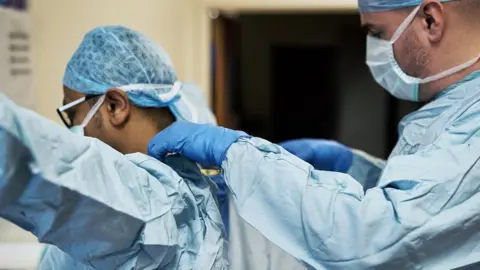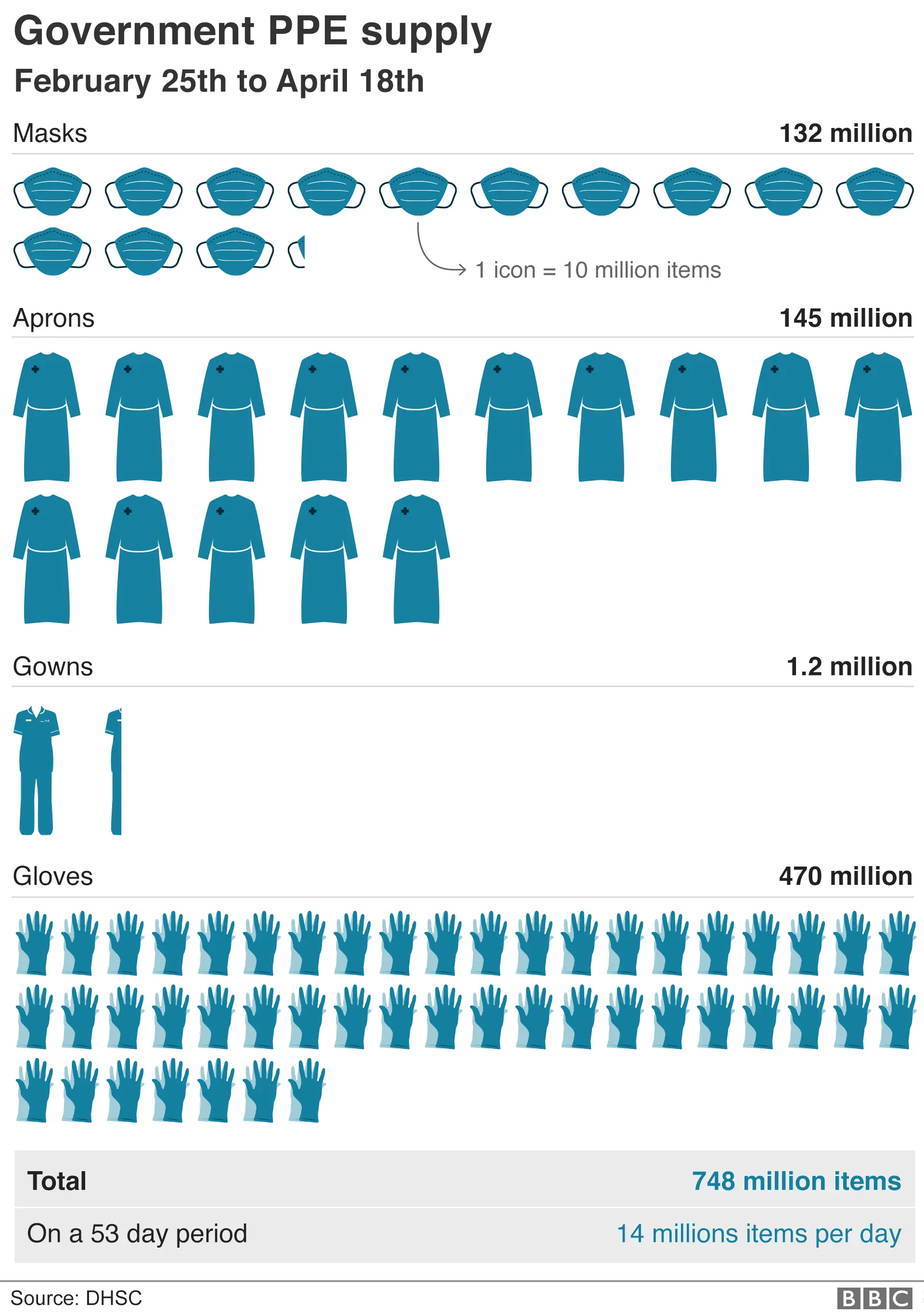Why a billion items of PPE is not enough

 Getty Images
Getty ImagesAt almost every government press conference, very big numbers are mentioned in connection to items of personal protective equipment (PPE) being distributed to those on the front line of the fight against the coronavirus.
Huge stockpiles are being distributed. The army has been called in. Civil servants have been told to scour the world for supplies. In the early days of the crisis 170 million items of PPE were distributed, soon it was 460 million, then 760 million, and now over a billion items have been delivered to the NHS staff risking their own lives to save others.
Yet, at the same time, medical staff, their unions, caregivers and first responders - well beyond the NHS - have clearly shown that they don't have the protective gear they want, and need.
Both seemingly contradictory claims can be true at the same time.
To understand why, it is necessary to take a deep dive in to the supply chain for PPE. That begins with the factories at the very epicentre of the virus in Hubei province, which specialise in making medical overalls, and ends in the UK's intensive care units, GP's surgeries and care homes.
This is an issue that takes in economics, business, trade, politics, diplomacy, forecasting and a knowledge of just-in-time supply chains.
It has proved that powerful governments can be powerless without the help of the world's biggest companies who actually know how to operate across these disciplines.
Not enough
And it matters because it directly affects the health and safety of our medical professionals and their patients. But it will go well beyond that to shape life as we know it beyond that lockdown.
That's because we will not be able to reopen the economy, until there is enough PPE to help medics deal with new - and possibly recurring - waves of Covid-19. Then we will need more protective gear for other services - and it is increasingly plausible the general public will need it too.
In short, in this new world, a billion items will not be enough.
 Getty Images
Getty ImagesWhat matters is the size of the stockpile, the supply chain to distribute it, the daily usage rates, and the ability to get more.
The government has been coy about some of these details, preferring to give information on total items moved and, recently, on the weight of imports. But parts of the puzzle can be put together.
The latest figures show that in the 53 days between 25 February and 18 April, over a billion items of PPE were delivered across the UK. That figure includes 875 million items sent to NHS Trusts in England. But that also includes some items not universally considered to be frontline PPE, such as body bags, pulse oximeters, swabs, clinical waste containers, cleaning equipment and detergent.

The actual breakdown offered by the Department of Health and Social Care looks like this: 132 million masks; 145 million aprons; 1.2 million gowns; and 470 million pairs of gloves.
That adds to 748 million items, or 14 million items a day over a 53 day period.
Importantly, the bulk of those items are in fact gloves. And, as we will show, there is no evidence that half of demand is for gloves.
Masks, aprons and gowns are another narrower measure of supply. In total 276 million were delivered over that 53 day period, 5.2 million a day.
But how does that compare to demand?
There are no national figures being supplied on this so far. But individual trusts are calculating their daily usage rates, comparing them to stock levels and calculating how many days' supply they have left. This is how we know of the current acute shortage of gowns.

- EASY STEPS: How to keep safe
- A SIMPLE GUIDE: What are the symptoms?
- CONTAINMENT: What it means to self-isolate
- HEALTH MYTHS: The fake advice you should ignore
- MAPS AND CHARTS: Visual guide to the outbreak

Yesterday, a government minister, Matt Warman, released all those details for one NHS hospital trust: the United Lincolnshire Hospital Trust, which covers three hospitals with intensive care units, four in total. Although they don't service the entire population of Lincolnshire.
Even in an area with relatively few Covid-19 infections, the daily use of PPE is pretty staggering: 39,500 surgical masks per day, 11,495 gloves, 1,501 gowns and 4,201 highly-protective FFP3 respirator masks, as well as aprons and eye protectors. That sums to a staggering 72,000 items a day in for one trust, alone.
 Getty Images
Getty ImagesIt gives some sense of the scale of PPE usage in the NHS. The United Lincolnshire Hospital Trust trust has seen just 0.5% of NHS England's coronavirus-related deaths. The county represents about the same proportion of cases, and it has the same proportion of England's hospitals. The trust is one of 223 hospital trusts in England.
If the number of items of PPE used by that trust is in line with the rest of NHS England - accounting for Covid-19 cases and deaths - then across the country, between 10 million and 16 million items of protective gear would be needed each day. That compares to the 14 million units a day the government says it has distributed on average, since 25 February. The NHS, the Department of Health and Social Care and devolved administrations have not yet given actual figures on this.
But well over half of the 14 million units supplied are pairs of gloves. In Lincolnshire, gloves account for just a sixth of the PPE items used each day.
Billions needed
Stripping out what seems to be a surplus of gloves changes the picture. In Lincolnshire, the hospital trust used 55,061 masks, aprons and gowns each day. If its use of these items is typical of the NHS at large, the range of daily demand would be between 7.5 million to 12 million, more than the 5.5 million actually supplied.
This does not prove that there is undersupply. Lincolnshire might be an outlier. There might be very specific arrangements or policies in place at that trust, that make it difficult to compare to the rest of the country.
But right now it is the only data on daily usage rates there is. Other countries, such as France, have released weekly usage stats for some forms of PPE (they use 45 million masks a week, in case you were wondering). Scaling up the Lincolnshire trust's numbers would point to UK weekly usage of 55 million, a similar order of magnitude.
These numbers provide a guide that enables us to suggest that the "billion" figure is not so big in relation to demand when it is spread out over seven weeks or so.
And that raises reasonable questions about whether it is enough - and whether it will be enough. Add in demand for PPE in care settings, councils, mortuaries, volunteer organisations, and eventually even the general public, and the scale of the challenge becomes clear.
Billions (plural) of items will be needed. A billion is not enough, particularly when nearly half of it is gloves.
